Select Works of Raymond Edward Brown (12 vols.)
Digital Logos Edition
Overview
Raymond Edward Brown is lauded as the finest New Testament scholar of his time in America. Always brilliant and occasionally controversial, Brown pioneered the use of the historical-critical method of scriptural analysis among Catholics and was the first Catholic professor to gain tenure at Union Theological Seminary. His works were influential—particularly those on Christology, Johannine literature, and the birth and death of Jesus Christ.
Among the 12 volumes in this collection, you’ll find Brown’s two-volume The Death of the Messiah, from Gethsemane to the Grave—the crowing jewel of a distinguished career. Other works include Sensus Plenior, which explores the use of Scripture in its various senses through the ages; Priest and Bishop, examining the biblical basis of priesthood; and Recent Discoveries and the Biblical World, which discusses 25 significant archaeological and documentary finds. Included from the Anchor Yale Bible series are Brown’s magisterial commentary on the Gospel according to John—examining all of the major Johannine questions of authorship, composition, dating, and the relationship of John to the Synoptic Gospels—as well as an in-depth analysis of the Johannine Epistles.
These volumes will inspire students to develop greater insight and understanding for the Church’s Scripture and Tradition.
This collection is part of the Modern Catholic Authors Bundle (243 vols.).

- Presents the wisdom of a preeminent New Testament scholar
- Explores a variety of biblical texts and theological topics
- Includes Brown’s two-volume commentary on the Passion narrative
Father Raymond Brown has a strong claim to be the most distinguished of American New Testament scholars, and he has few competitors worldwide.
—New York Times
The most distinguished and renowned Catholic biblical scholar to emerge in this country, ever.
—Cardinal Roger Mahony, Archbishop of Los Angeles
The premier Johannine scholar in the English-speaking world.
—Francis J. Moloney, professor of New Testament, Catholic University of America
- Title: Select Works of Raymond Edward Brown
- Author: Raymond Edward Brown
- Volumes: 12
- Pages: 6,373
- Christian Group: Catholic
- Resource Type: Monographs, Commentaries, Collected Works, Introductions
- Topic: Biblical Studies, Theology, Textual Criticism, Exegesis
- An Introduction to the Gospel of John
- An Introduction to the New Testament
- Biblical Exegesis and Church Doctrine
- Priest and Bishop: Biblical Reflections
- Recent Discoveries and the Biblical World
- The Anchor Yale Bible: The Gospel according to John I–XII
- The Anchor Yale Bible: The Gospel according to John, XIII–XXI
- The Anchor Yale Bible: Epistles of John
- The Birth of the Messiah: A Commentary on the Infancy Narratives in the Gospels of Matthew and Luke
- The Death of the Messiah, from Gethsemane to the Grave, Vol. 1
- The Death of the Messiah, from Gethsemane to the Grave, Vol. 2
- The Sensus Plenior of Sacred Scripture
This title is included in the following collections
You can save when you purchase this product as part of a collection.
Modern Catholic Authors Bundle...
$2,499.99$2,499.992025 Ultimate Library
$23,999.99$17,999.99Logos 8 Ultimate Legacy Librar...
$21,749.99$21,749.99Logos 9 Ultimate Legacy Librar...
$24,999.99$24,999.99

An Introduction to the Gospel of John
- Author: Raymond Edward Brown
- Publisher: Yale University Press
- Publication Date: 2003
- Pages: 384
When Raymond E. Brown died in 1998, less than a year after the publication of his masterpiece, An Introduction to the New Testament, he left behind a nearly completed revision of his acclaimed two-volume commentary on the Gospel of John in the Anchor Yale Bible (86 vols.). The manuscript, skillfully edited by Francis J. Moloney, displays the rare combination of meticulous scholarship and clear, engaging writing that made Father Brown’s books consistently outsell other works of biblical scholarship.
An Introduction to the Gospel of John represents the culmination of Brown’s long and intense examination of part of the New Testament. One of the most important aspects of this new book, particularly to the scholarly community, is how it differs from the original commentary in several important ways. It presents, for example, a new perspective on the historical development of the Gospels, and shows how Brown decided to open his work to literary readings of the text, rather than relying primarily on the historical, which informed the original volumes. In addition, there is an entire section devoted to Christology, absent in the original, as well as a magisterial new section on the representation of Jews in the Gospel of John.
A bittersweet read! Intended as the introduction to a major revision of the landmark Anchor Yale Bible commentary on John, but sadly cut off by his death in 1998, this work stands alone as a magnificent survey of major issues in the study of the Fourth Gospel. With his accustomed thoroughness and respect for the work of others, even in disagreement, Brown updates and often moves beyond positions first articulated over three decades ago. Scholars will be long in debt to Francis Moloney for his own insightful introduction and conclusion as well as for signposts along the way which point to shifts in Brown's work along with developments subsequent to his death, and current bibliography. This eminently readable work will extend the influence of Brown well into the present century.
—John Donahue, Raymond E. Brown Distinguished Professor of New Testament Studies, St. Mary’s Seminary and University
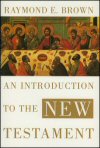
An Introduction to the New Testament
- Author: Raymond Edward Brown
- Publisher: Yale University Press
- Publication Date: 1997
- Pages: 928
From the experience of a lifetime of scholarship, preaching, teaching, and writing, Raymond E. Brown covers the entire scope of the New Testament with ease and clarity. He walks readers book by book through the basic content and issues of the New Testament. While a wealth of information is contained in these pages, the work’s most impressive features are the basic summaries of each book, a historical overview of the ancient Greco-Roman world, discussions of key theological issues, and the rich supplementary materials, such as illustrative tables, maps, bibliographies, and appendixes. Using this basic data, Brown answers questions raised by today’s readers, relates the New Testament to our modern world, and responds to controversial issues, such as those raised by the Jesus Seminar.
Every generation needs a comprehensive, reliable Introduction to the New Testament that opens the biblical text to the novice. Raymond E. Brown’s An Introduction to the New Testament is the most trustworthy and authoritative guidebook for a generation seeking to understand the Christian Bible.
Universally acknowledged as the dean of New Testament scholarship, Father Brown is a master of his discipline at the pinnacle of his career. Who else could cover the entire scope of the New Testament with such ease and clarity? This gifted communicator conveys the heartfelt concern of a beloved teacher for his students, as he walks the reader through the basic content and issues of the New Testament. Those opening to the New Testament for the first time and those seeking deeper insights could not ask for more in a primer to the Christian Bible.
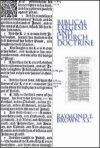
Biblical Exegesis and Church Doctrine
- Author: Raymond Edward Brown
- Publisher: Wipf & Stock
- Publication Date: 1985
- Pages: 171
In this book, Raymond Brown reflects on the interplay between biblical criticism employed by a majority of Roman Catholic scholars and the doctrinal proclamations of the Catholic Church. He also presents his argument for how liberals and ultraconservatives both misinterpret the effects of biblical criticism on doctrine. He gives special attention to the positive results of contemporary biblical studies for the understanding of Mary, the Holy Spirit, and the Church.
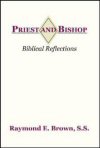
Priest and Bishop: Biblical Reflections
- Author: Raymond Edward Brown
- Publisher: Wipf & Stock
- Publication Date: 1999
- Pages: 86
This booklet presents Raymond Brown’s thoughts on the biblical basis of priesthood, as well as some reflections on the role of bishop. Not setting out to give a “complete, scientific treatment of the biblical background of priesthood,” he presents his intentions for compiling these reflections this way: “I have culled the Scriptures to offer material for thought at a crucial moment in the history of the Roman Catholic priesthood. With the whole Christian world looking on, we Catholics have entered a sometimes acrimonious debate with ourselves as to what should be expected of those who are in the special ministry of the Church . . . What manner of life should our priests live and work should they do?”
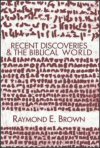
Recent Discoveries and the Biblical World
- Author: Raymond Edward Brown
- Publisher: Wipf & Stock
- Publication Date: 2003
- Pages: 101
One of the most fascinating aspects of biblical research today involves Near East discoveries and how they cast light on the Bible. This text by Raymond E. Brown is a handy guide which discusses twenty-five of the most significant archaeological and documentary finds of our times, and explains how they broaden our knowledge of the biblical world. This book provides helpful photographs and illustrations to enhance your study, as well as an insightful introduction by the author in which Brown recounts how for himself, reading of such discoveries sparked him to commit his life to formal Bible study and helped him develop his cardinal principle of biblical interpretation: viewing the Bible as the “word of God” involves a combination of divine inspiration and human time-conditioned perception.
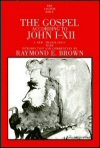
The Gospel according to John I–XII
- Author: Raymond Edward Brown
- Series: Anchor Yale Bible (AYB)
- Publisher: Yale University Press
- Publication Date: 1995
- Pages: 688
In the first volume of Raymond E. Brown’s magisterial commentary on the Gospel according to John, all of the major Johannine questions—of authorship, composition, dating, the relationship of John to the Synoptics (Mark and Luke)—are discussed. The important theories of modern biblical scholarship concerning John are weighed against the evidence given in the text and against prevailing biblical research. In sum, what is attempted is a synthesis of the major scholarly insights that bear on the fourth Gospel.
The translation—as Raymond E. Brown states at the outset—strives not for any formal beauty but rather for an accurate and contemporary version: “the simple, everyday Greek of the Gospel has been rendered into the ordinary American English of today.” The result is a translation that will strike the reader with uncommon immediacy.
Brown also analyzes, in the appendixes, the meaning, use, and frequency of certain key words and phrases that occur in John, and examines the differences between the Johannine and Synoptic treatments of the miracle stories.
The chapters of the Gospel translated here (1–12) comprise the prologue, which opens with the famous “In the beginning was the Word,” and the Book of Signs, an account of the miracles of Jesus and of his ministry.
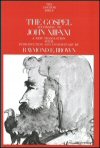
The Anchor Yale Bible: The Gospel according to John, XIII–XXI
- Author: Raymond Edward Brown
- Series: Anchor Yale Bible (AYB)
- Publisher: Yale University Press
- Publication Date: 1970
- Pages: 688
John 13–21 comprises the Book of Glory (describing the Last Supper, the Passion, and the appearances of the risen Jesus) and the epilogue to the Gospel. This commentary includes a special appendix on the Paraclete, in which Raymond E. Brown examines in detail the role of the Holy Spirit. Whether discussing John’s version of miracle stories found in the other Gospels, explaining the meaning of obscure Greek words, or showing the relevance of Jesus’ words and deeds, Raymond E. Brown speaks to scholars and laypeople alike.

The Anchor Yale Bible: Epistles of John
- Author: Raymond Edward Brown
- Series: Anchor Yale Bible (AYB)
- Publisher: Yale University Press
- Publication Date: 1995
- Pages: 840
With this study—companion to the masterful two-volume The Gospel according to John—Raymond E. Brown completed his trilogy on the Johannine corpus. Meticulous in detail, exhaustive in analysis, persuasive in argument, it examines controversies that have long troubled both biblical scholars and lay readers. Questions of authorship, composition, and dating, as well as the debate over source theories, are discussed at length; but these are kept subordinate to the overall question of meaning.
What gives this commentary special interest and excitement is the bold, imaginative reconstruction of the setting of the Johannine work—in particular of the “opposition figures,” who are only dimly sketched in the Epistles—so that we see clearly that the author is writing to his flock both about the dangers and difficulties confronting them, and about the eternal life that is theirs by the gift of God. In this way, the Epistles of John become intelligible as broadsides in a critical engagement between the forces of light and darkness.
In addition to his superb textual analysis of the letters, Raymond E. Brown has brought to life the community in which these works were formed and shaped. We are forcefully reminded that the Gospel and the Epistles were addressed to very real people living in the first century AD, people with religious problems not unlike our own. In all respects, The Epistles of John stands out as a model of biblical scholarship and study.
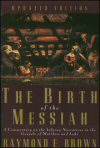
The Birth of the Messiah: A Commentary on the Infancy Narratives in the Gospels of Matthew and Luke
- Author: Raymond Edward Brown
- Publisher: Yale University Press
- Publication Date: 1999
- Pages: 752
In some ways the narratives of Jesus’ birth and infancy are the last frontiers to be crossed in the critical approach to the Gospels. For some, the stories of Jesus’ birth are given dubious historical value. For others, the popular character of these narratives—the exotic magi, birth star, angelic messengers, and so on—renders them as legends unworthy to be a vehicle of the pure Gospel message. Still others deem them simple Christian folklore devoid of any real theology—only written for romantics or the naïve. Yet each Christmas, Christian clergy and the people to whom they minister must continue to face them.
According to Raymond Brown, introductory materials on the New Testament in general and the Gospels in particular gives the infancy narratives short shrift, disproportionate to their role in Christian theology, art, and poetic imagination. Perhaps the most visible sign of this neglect is the absence of a major modern commentary which treats the two infancy narratives together.
It was from this felt need that efforts for a new commentary were undertaken. In The Birth of the Messiah, Raymond Brown is interested in the role the infancy narratives played in the early Christian understanding of Jesus. By treating the two narratives together in the same volume, Brown points out their common tendencies and emphases. By giving them two distinct treatments, however, he also shows how each fits within the theological framework of its respective Gospel, and thus offers us reasons for the differences between the infancy narratives.
In The Birth of the Messiah, Brown contends that the infancy narratives are, indeed, worthy vehicles of the Gospel messages. In fact, they contain the Gospel message in miniature. On a deeper level, this commentary reflects the instinct recognizing the infancy narratives as the essence of the Good News—namely, that God has made himself present to us in the life of the Messiah who walked the earth.
A line-by-line exegesis . . . that not only synthesizes a generation of modern scholarship but also provides a coherent and compelling explanation of what the stories of Christ's birth were meant to convey . . . Brown manages to rescue the Christmas story from both the contempt of experts and the sentimentality of naive laymen . . . Ordinary Christians can thank this priestly scholar for helping them to put the adult Christ back into Christmas.
—Newsweek
A work of highest critical historical scholarship in a form that is accessible to the average well-educated reader . . . Brown's treatment of the infancy narratives is definitive. It will undoubtedly be the standard work on the subject for years to come.
—Best Sellers
Recommended to readers at all levels and without reservation.
—America
A masterly work. Every conclusion is argued with the utmost thoroughness.
—Catholic Biblical Quarterly
A magnificent tome, which puts previous studies in the shade and which promises to remain standard for a very long time. A superb study, rich in content, profound in insight.
—The Living Church
One of the premier events in biblical publishing. . . . One thing is sure: This book will become a classic study on the nature and message of the infancy and message of the infancy narratives.
—The Bible Today

The Death of the Messiah, from Gethsemane to the Grave, vol. 1
- Author: Raymond Edward Brown
- Publisher: Yale University Press
- Publication Date: 1998
- Pages: 912
The Passion Narrative proceeds from arrest through trial to condemnation, execution, and burial. In each Gospel, it records the longest consecutive action of Jesus. It has captured the attention and imagination of dramatists and artists, and it has inspired the poetry and music of the church for two thousand years. Alongside “born of the Virgin Mary,” the other phrase that made its way into the creed, “suffered under Pontius Pilate,” has become a marker anchoring Christian belief about the Son of God to a Jesus who was a human figure of actual history.
Historically, Jesus’ death was the most public event of his life. Theologically, Christians have interpreted the death of Jesus on the cross as a key element of God’s plan for the justification, redemption, and salvation of all. Spiritually, the Jesus of the Passion has been the focus of Christian meditation for countless would-be disciples who take seriously the command of the Master to take up the cross and follow him. Pastorally, the passion is the centerpiece of Lent and Holy Week, and the most sacred time in the liturgical calendar. From every point of view, the Passion is the central narrative in the Christian story.
The massive amount of material written on the Passion Narrative creates a need for a work that brings together the scattered views, proposals, and interpretations. In this work, Raymond Brown sifts through the material to offer a full-scale commentary on the Passion Narratives of the Gospels.
The Death of the Messiah serves a variety of audiences: scholars, pastors, students of the religion and theology of the Bible, interested Christians, and those of any persuasion who seek knowledge about the passion and death of Jesus. Brown treats subjects in a readable way, even when it requires greater length or exposition.
Volume 1 covers the scenes of Jesus in Gethsemane, Jesus before the Jewish authorities, and Jesus before Pilate. This volume contains translation, commentary, and analysis of each passage.
Once again Raymond Brown has written a magnum opus. A stunning array of fresh insights into how the passion stories came into being and what—scene by scene—the four Evangelists really say about the arrest and crucifixion of Jesus.
—Newsweek
Father Raymond Brown has a strong claim to be the most distinguished of American New Testament scholars, and he has few competitors worldwide.
—New York Times
The Death of the Messiah is first of all a scholarly work, but it is also enjoyably readable and accessible to the interested layman.
—Newsday
Breathtaking! Raymond E. Brown’s The Death of the Messiah crowns two millennia of Christian scholarship pondering the ‘scandal of the crucifixion.’ Brown has once again demonstrated his position as Father, Rabbi, and Teacher to us all.
—Burton L. Visotzky, professor of Talmud and Rabbinics, Jewish Theological Seminary
The supreme achievement of a deeply pastoral scholar.
—Sandra M. Schneiders, professor of New Testament studies and Christian spirituality, Jesuit School of Theology and Graduate Theological Union
The benchmark by which any future study of the Passion Narratives will be measured.
—John P. Meier, professor of New Testament, University of Notre Dame
These volumes are a treasure that spans the ages.
—Phyllis Trible, professor, Wake Forest University Divinity School
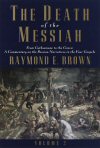
The Death of the Messiah, from Gethsemane to the Grave, vol. 2
- Author: Raymond Edward Brown
- Publisher: Yale University Press
- Publication Date: 1998
- Pages: 752
Volume 2 continues Raymond Brown’s project of commentary and analysis of the Passion Narrative, covering the scenes of Jesus’ crucifixion and burial. This volume also contains nine appendices on non-canonical passion narratives, historicity, views of Judas Iscariot, Old Testament background, and Jesus’ predictions of his death. Volume 2 concludes with a detailed bibliography and a 25-page subject index.

The Sensus Plenior of Sacred Scripture
- Author: Raymond Edward Brown
- Publisher: St. Mary’s University
- Publication Date: 1955
- Pages: 161
This work, published in 1955, is a dissertation Raymond Brown wrote at St. Mary’s University in Baltimore. It deals with the notion of sensus plenior or “fuller sense,” a term in biblical exegesis first used by Andres Fernandez, S.J. in the late 1920s. This new hermeneutic classification sparked a complicated dispute in Catholic circles in the years following, to which Brown adds his voice in this text. Brown defines sensus plenior as “that additional, deeper meaning, intended by God but not clearly intended by the human author, which is seen to exist in the words of a biblical text (or group of texts, or even a whole book) when they are studied in the light of further revelation or development in the understanding of revelation.” Brown explores the use of Scripture in its various senses through the ages, explains the divisions of sensus plenior and its relations to other senses of Scripture, examines the objections raised against it, and much more.
Raymond Edward Brown (May 22, 1928–August 8, 1998) was a Sulpician priest and internationally regarded as the dean of New Testament scholars. He taught for many years at Saint Mary’s Seminary in Baltimore and was Auburn Distinguished Professor Emeritus of Biblical studies at Union Theological Seminary in New York City, where he also taught for 29 years. Over his lifetime he was awarded more than dozen honorary doctorates from American and European universities and was commended by Pope Paul VI for his “learning, prudence, and Catholic regard for the Magisterium of the Church.” He authored more than 35 books, including three volumes of commentary on John in the Anchor Yale Bible series.
Reviews
0 ratings
Ryan Brady
12/3/2020
Fr. Brown's writings are very apt to lead to heretical understandings of basic elements of the Catholic faith. I regret that I spent money on his books. Why do I say what I do? Well, in his first Union Theological Seminary lecture, in 1971, sounded a well-publicized call for "a scholarly reassessment" of the historical accuracy of Jesus' conception and virginal birth. Moreover, in his "Biblical Exegesis and Church Doctrine (1985)", he put the Virgin Birth — a central dogma of the Catholic faith — in the category of "doctrines for which there is slender basis in Scripture." Fr. Brown had way too much influence on biblical studies. In part, Ratzinger's excellent "Erasmus Lecture" was directed against Brown's modernist reading of Sacred Scripture (and, in fact, Brown got very upset by it as friend of mine who was there told me). Fr. Brown and many of those Catholic exegetes who followed him hold that it is "very uncertain" that angels appeared to Mary and Joseph; that there appeared a star interpreted by magi from the east as a sign of the birth of the King of the Jews, and that they followed it to Bethlehem; that angels appeared to the shepherds; and that Mary and Joseph lived in Nazareth. Don't waste your time and money. The earlier Brown is forgotten, the better. Also, another commenter (who also has a Ph.D. with a concentration in biblical studies as I do), argues that since Brown was put on the PBC, he was fine. Actually, it was only after Paul VI downgraded the authority of the PBC by making it be no longer a part of the Magisterium that he was allowed on it.
Patrick J. Madden
5/14/2019
I own "hard copy" of all of these works, and the Logos version of the great majority of them. Ph.D.'s like myself are a dime a dozen. Raymond Brown became the president of the Catholic Biblical Association of America. Fewer than 1% of us have such an honor. In addition to this, Raymond E. Brown was the first Catholic ever to be elected as president of the Society of Biblical Literature. You can count the number of Catholics who have held this position and still have fingers left over. In addition to these great honors, Raymond E. Brown served as a member of the Pontifical Biblical Commission, one of 24 scholars (12 NT, 12 OT) appointed to advise the pope on biblical matters. Brown has been criticized by some ultra-conservative Catholics, but one does not get appointed to the PBC by being a "loose cannon." I heartily recommend the works of Raymond E. Brown to anyone who wishes to learn more about how the 20th-century renewal of biblical studies in the Catholic Church continues to affect Catholic participation in ecumenical and inter-religious dialogue.